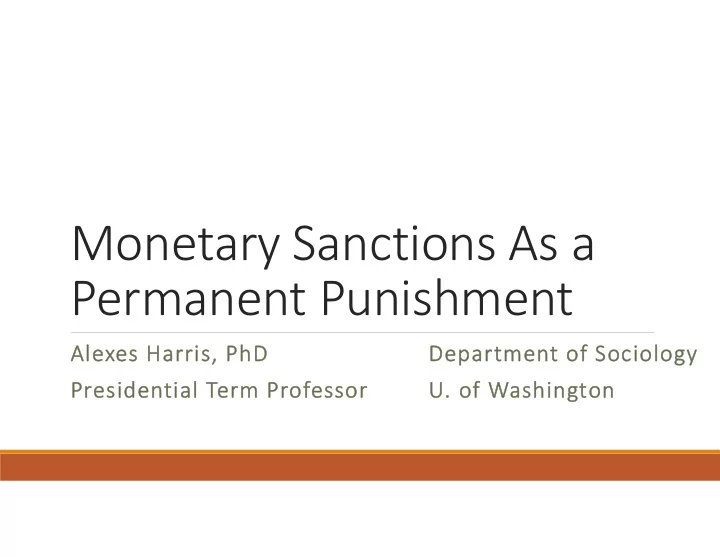

Monetary Sanctions As a Permanent Punishment Alexes Harris, PhD Department of Sociology Presidential Term Professor U. of Washington
I. Framing the Problem
The Issue: Monetary Sanctions Legal Financial Obligations (LFOs) Costs associated with justice system contact People are required to pay for services and sentences An involuntary system Court supervision and control extend until people pay in full Certain rights limited until paid Leads to a two‐tiered system of justice
Police Arrest Immigration Pre/Post Cost of defense attorney Incarceration Detention release bond Cash Bond/Bail Bond Phone calls, internet, “Pre-pay Release Cards” visits) Asset forfeiture Jail/prison cost Financial Related LFO deduction Jail booking fee Consequences Expungement of record Loss of driver’s license Deferred prosecution Black = Private Wage garnishment Underline = w/o conviction Figure 1. The System of Monetary Sanctions in U.S. Institutions of Justice “Alternative” Sentences Victim panel class Costs if Can’t Pay in Full Conviction Probation Collections fee Jail/prison cost Drug/Alcohol Assessment & “Convenience” fee Restitution Treatment Interest LFOs – fines, Electronic Home Monitoring Per payment cost, min. fees, costs Work Release Alexes Harris, 2018
Examples of WA Private Entities
Figure 2. The Layers of Monetary Sanctions Juvenile Traffic Misdemeanor Tickets Federal District Felony Court Various Citations Alexes Harris, 2018
II. WA State Data Preliminary Data Analysis cases 2000‐2014 WA State Administrative Office of the Courts Automated Court Data Statistical Support: Frank Edwards, PhD, Cornell University Grant Support: Laura and John Arnold Foundation
Figure 3. Total Amount Fines and Fees ordered by WA State Court Level, 2000‐2014. Harris & Edwards, 2018
Figure 4. Total Amounts Collected and Outstanding WA State Court Type, 2000‐2014. Harris & Edwards, 2018
Figure 5. Amount of Sentences by Court and Case Type, WA State, 2000‐2014. Harris & Edwards, 2018
Figure 6. Numbers of Cases/Tickets Filed by Case Type (CLJ), WA State, 2000‐2014. Harris & Edwards, 2018
Understanding Racial & Ethnic Inequality in Sentencing & Paying Practices Aggregate analysis examining racial and ethnic disproportionality in Washington State LFO Sentencing
Figure 7. Median Sentence Per Person by Race & Ethnicity, WA Superior Courts, 2014. Harris & Edwards, 2018
Figure 8. Per Capita Rate of LFO Balance in Superior Courts by Race/Ethnicity, WA Superior Courts, 2014. Harris & Edwards, 2018
Figure 9. Percent of Population With New LFO Cases by Race/Ethnicity, WA Superior Court, 2014. Harris & Edwards, 2018
Figure 10. Age of LFO Accounts, WA Superior Court, 2000‐2014 Harris & Edwards, 2018
Summary Varying sentencing, collection, and debt processes across the three major court types • CLJ Collect 33 times more revenue than Superior courts • Sentencing amounts have decreased in Superior Court since 2005, but has increased dramatically in CLJ since 2008 • CLJ collect 45‐57% of what was sentenced in 2014, Superior Courts 11% • Traffic infraction sentencing increased dramatically Racial and Ethnic Disproportionality • Differences in collection trends suggests an inability to pay for Black, Latinx and Native American • Black, Latinx and Native American people are sentenced LFO more frequently and at higher rates than Whites and Asian/Pacific Islanders
III. (a) Data Implications • Specific data elements: • Was community service offered in lieu of payment? • Did the jurisdiction provide a comm. Service program? • comm. Service used for payment adjustment? • Was a payment calculator used to establish sentence and payment amounts? • Seattle Municipal should be combined with State AOC for comparison of practices across the state • Need more information about private contracts with our public jurisdictions • What are the private practices and policies used to collect money from people? • How much of a profit is being made by private entities who replace a public good? • What might be the trade offs (e.g., public safety, increased costs to poor people?
III. (b) Policy Implications Ability to pay hearings for all types of monetary sanctions sentenced Community service alternative Fines/fees/restitution calculated by individuals’ average daily wage (day fine) Need to address court funding and expenditures What are ways to decrease costs? How can budgets be restructured to provide appropriate revenue to courts?
Alexes Harris Presidential Term Professor Department of Sociology University of Washington Email: yharris@uw.edu Twitter: @alexesharris Website: alexesharris.Com
Follow‐up Slides
Sources re: privatization of services and costs Kitsap county jail release cards: https://www.prisonlegalnews.org/news/2017/dec/5/hrdc‐sues‐ kitsap‐county‐washington‐over‐debit‐release‐cards/ Washington State DOC phone calls: http://www.doc.wa.gov/corrections/incarceration/visiting/phone‐vendor.htm Seattle Municipal Court: http://www.seattle.gov/courts/tickets‐and‐payments/pay‐my‐ticket
Recommend
More recommend